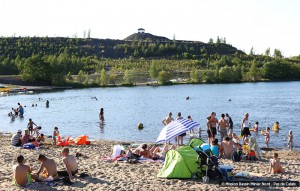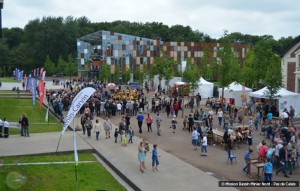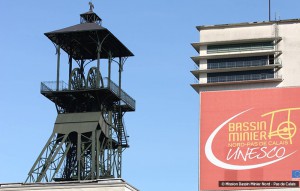New-found appeal and acclaim

« What do we get out of it? » is a frequent question asked by the inhabitants of sites listed as UNESCO World Heritage. With the exception of sites under threat – which thankfully is not the case for the Mining Basin – the World Heritage Committee’s decision does not garner any financial rewards. However, obtaining the label can have a great knock-on effect, promoting tourism and the economy.
While this was not the primary aim, the Mining Basin’s inscription in 2012 has potential to make it a great tourist destination located at mid-point between Brussels, Paris and London. All the more because inscription coincided with the opening of the Louvre-Lens museum. This prestigious museum attracts half a million visitors a year, joining other places of interest in the Mining Basin such as the Historic Mining Centre in Lewarde (150,000 visitors/year) and the memorials and cemeteries commemorating soldiers from the two World Wars (500,000 visitors/year).
At a time when new types of tourists are looking out for original, cultural or sporting breaks, the buzz created by the industrial heritage of the Mining Basin was perfectly timed to make it an attractive destination. Looking beyond the boost to tourism, international recognition that comes with the « World Heritage » stamp has another, immediate effect: the Mining Basin has been put on the map! Previously unknown beyond French borders, it now features on the global scene. Moreover, it puts forward a positive image of an area with rich heritage, inhabited by go-getting stakeholders capable of sustaining it. This boosts its appeal with investors, executives and students from abroad.

A new sense of pride

However being listed as World Heritage has not only changed outsiders’ views. It also has an effect within the territory. For a long time, mining architecture and landscapes generated only indifference and incomprehension, even disdain. This industrial heritage sometimes used to be a heavy burden. Its new-found recognition as valuable heritage has now made it a source of pride for Mining Basin inhabitants. Locals have long nurtured a taciturn attitude with a tendency to self-criticism. Living in a « World Heritage » territory has helped to free them of inhibitions and boost their self-esteem. In an area that has often fallen victim to petty squabbling, the « World Heritage » adventure has additionally provided proof that joining forces can bear fruit. Cooperation is essential in order to count for something when competing on the national or international scene. Inscription in 2012 lastly demonstrates that the Mining Basin can fulfil requirements and lay claim to better quality in architecture and the environment to build projects for the future. These are all factors contributing to more ambition and a huge boost in confidence from an economic point of view. In particular among young people who are inspired to continue studying or start up a company. As a concrete illustration of this process, key mining heritage sites, namely the five major collieries, look set to become economic and cultural centres, serving as a link between yesterday’s industry and the knowledge-based economy of tomorrow. The 11/19 sites in Loos-en-Gohelle (eco-industry), 9-9bis in Oignies (logistics) and the Wallers-Arenberg colliery (creative graphics) now have centres for training, innovation and research which are to help the Mining Basin leave behind the primary economy (coal mining and auto assembly) which has been its single focus for too long. To at last master development that’s « sustainable » in every sense of the word.


